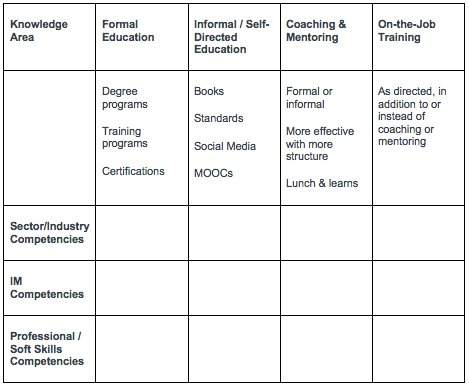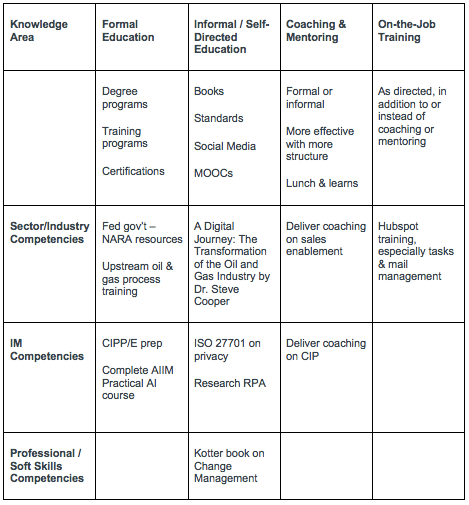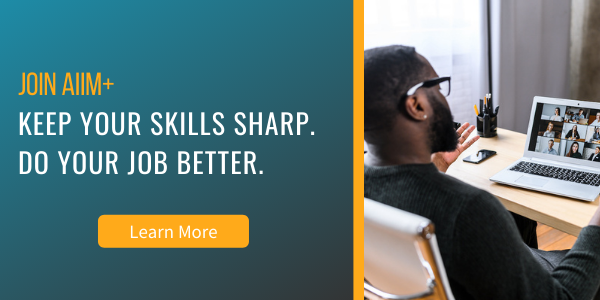
A Guide to Professional Development for the Information Professional
Certified Information Professional (CIP)
Once you stop learning, you start dying.
-- Albert Einstein
By now, you’ve probably heard all the statistics on how much information we create, how much faster we create it, and how much harder it is to manage. While these statistics are all true, there’s an opportunity for information professionals in all this chaos. Organizations desperately need someone to help them clean up their digital landfills.
But where do you begin?
What Information Professionals Need to Know
Part of the challenge associated with effective information management is that it’s just so big. There are so many different disciplines, processes, and a seemingly limitless variety of software and hardware solutions. With so many options, how do you determine where to focus your learning?
When AIIM updated the Certified Information Professional program in 2019, we identified a variety of information management-related concepts and tasks that every effective information management professional must understand. We grouped these into five domains:
- Creating and capturing information
- Extracting intelligence from information
- Digitalizing information-intensive processes
- Automating governance and compliance
- Implementing information management solutions
We also updated the CIP study guide, which functions as an information management body of knowledge (IMBOK). Use these domains as a map to identify important areas where you need to grow. We don’t expect any one information management professional to have deep expertise in all of these domains, but it is reasonable to assume an awareness of them and to consider them when planning any major information management-related initiative.
Different Paths to Professional Development
Now that you've started to identify WHAT you want to learn, you must choose HOW you would like to learn it. There are a variety of options to suit any budget, learning style, and time crunch.
Conferences in 2021 are a much different structure than what they were even up to a year ago. For many, including AIIM, the conference format has been translated to a virtual structure. The virtual format excites me because it is more accessible, more affordable, but delivers the same great content.
And when in-person conferences do make a come back, remember that some of the best learning doesn't always take place in breakout sessions or keynotes. Often, it’s the networking, hallway conversations, meetups, and "birds of a feather" sessions, where you get to learn from your peers. I’ve learned a lot from my colleagues at the hotel bar or while waiting for my turn at karaoke!
Webinars and virtual events are a great alternative when you’re short on time and money, but still desire great content on timely topics.
The market offers numerous sources of research on market trends, developments in information management, and benchmarking against your peers. Just here at AIIM, we release dozens of resources every year, ranging from eBooks and Industry Watch white papers, to infographics that distill down complex topics into talking points.
Training courses can provide you with a deep dive into a specific topic in a fairly short period of time. Instructor-led courses are always a good option because they offer that same peer-to-peer dialogue and learning as a conference. As a trainer myself, I learn from my students at every class I teach.
If you don’t have the time – or the travel budget – online learning can be an effective way to learn or reinforce skills on your own schedule. There are a lot of different options for training in the market. At AIIM, we offer courses on a variety of topics, and we think they’re pretty darn good! And they're all available as part of a subscription we call AIIM+.
Certifications are a bit of a different beast. Certifications are designed to demonstrate a candidate’s knowledge and understanding of a topic. This means that there are many different routes to get that knowledge and understanding, including but not limited to the ones I’ve outlined above. Getting a certification puts you in some pretty rarefied company, depending on the specific certification; it also serves as shorthand to an organization or a hiring professional that you know your stuff, and you can hit the ground running.
With all these options, what’s the best choice for you? I say, “Yes.” It depends on where you are in your career, what you’re trying to accomplish, your budget (including time and travel), and your interests. For me, it’s always been a combination of all the above. Next, I’ll outline the elements of a professional development plan, provide a template, and show you my personal, professional development plan using that template.
Your Professional Development Plan
What if we train our staff and they leave? What if we don’t – and they stay?
-- Often attributed to Henry Ford
Your final step is to put all of this together in a formal professional development plan. Every information professional – in fact, every professional – needs a professional development plan. You have to stay current in order to stay relevant. And relevance is relative: there’s a difference between staying where you’re at – treading water – and setting out to get a better position, more pay, or increased responsibilities. You’re the only one who knows what road you’re on – meaning you have to take responsibility for your own professional development plan.
We can’t tell you exactly what should go into your plan, but we’ve put together a framework that is comprehensive, yet flexible, to allow you to develop a plan that makes sense for you and your professional goals.

We’ve already talked about some of the learning mechanisms like conferences, webinars, and training. These are more formal options insofar as they are scheduled, cost money, etc., but this is only one approach. Many professionals have found success through less formal and more experiential sorts of approaches, such as on-the-job training, mentoring, and coaching. In addition, professionals should always cultivate and maintain an understanding of the foundational works within a discipline – industry standards, best practices, books that capture fundamental practices and processes, and so forth. And there are a variety of other less formal resources available, including industry magazines and blogs from associations, vendors, and individual thought leaders.
At the same time, we believe that professional development should be broad and comprehensive and that a well-rounded professional will work to improve in three areas: domain competencies, information management competencies, and professional or soft skills competencies.
- Domain Competencies are specific to a particular sector or industry, or to a particular horizontal work process. For example, an individual who worked as an HR manager in the upstream oil & gas sector could work to improve domain skills in employee onboarding or compensation, or in an understanding of the exploration & development process.
- Information Management Competencies are those we addressed in the CIP earlier. For information management professionals, these will be deep-dive expertise in the day-to-day requirements of their roles. For the aforementioned HR manager, it might be a more basic understanding of the importance of information management to effective onboarding.
- Professional or Soft Skills Competencies focus on those skills that make for a more effective employee, no matter the role. These include but are not limited to project management, change management, communication, and budgeting.
Our framework recommends that individual professionals look to this as a matrix. The individual employee would determine what skills to work on in each of these three areas and then would select learning mechanisms based on availability, timing, budgets, etc. This might be reviewed by the individual’s manager, particularly where approval for travel, a training course or conference, etc. is required, but ultimately, it’s the responsibility of individuals to determine their own appropriate learning paths and outcomes.
Here's a template for what this might look like:

And here’s an example of what *my* personal education plan currently looks like. I don’t have every box filled in, but I have most of them, and as I finish things on the plan, I add new ones.

There are other ways to do this, of course, and even within this framework, you'll need to determine the appropriate domain, IM, and professional competencies that apply. But this type of plan can readily be incorporated into annual reviews and helps to ensure that your professional development plan aligns to your personal and organizational goals.



